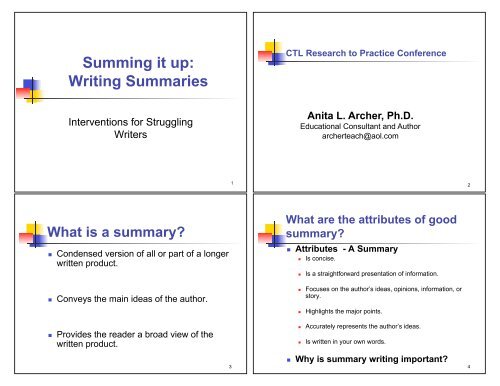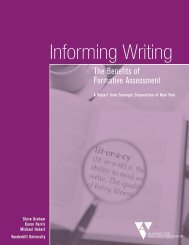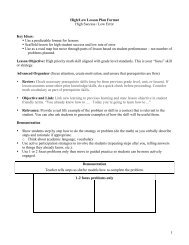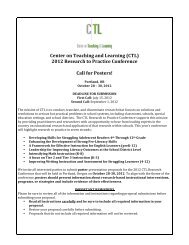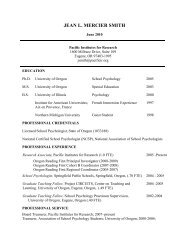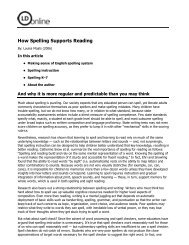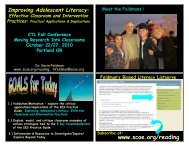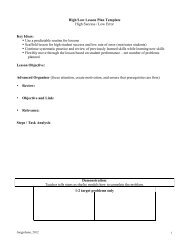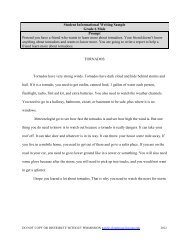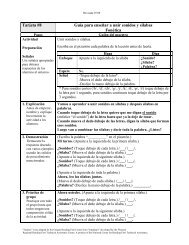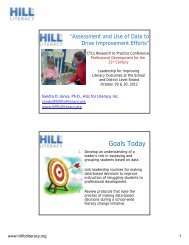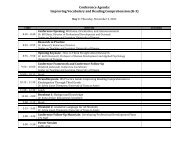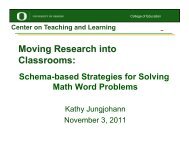4.2 Anita Archer - SummaryWriting - Handout - Center on Teaching ...
4.2 Anita Archer - SummaryWriting - Handout - Center on Teaching ...
4.2 Anita Archer - SummaryWriting - Handout - Center on Teaching ...
Create successful ePaper yourself
Turn your PDF publications into a flip-book with our unique Google optimized e-Paper software.
Summing it up:<br />
Writing Summaries<br />
CTL Research to Practice C<strong>on</strong>ference<br />
Interventi<strong>on</strong>s for Struggling<br />
Writers<br />
<str<strong>on</strong>g>Anita</str<strong>on</strong>g> L. <str<strong>on</strong>g>Archer</str<strong>on</strong>g>, Ph.D.<br />
Educati<strong>on</strong>al C<strong>on</strong>sultant and Author<br />
archerteach@aol.com<br />
1<br />
2<br />
What is a summary<br />
!! C<strong>on</strong>densed versi<strong>on</strong> of all or part of a l<strong>on</strong>ger<br />
written product.<br />
!! C<strong>on</strong>veys the main ideas of the author.<br />
What are the attributes of good<br />
summary<br />
!! Attributes - A Summary<br />
!! Is c<strong>on</strong>cise.<br />
!! Is a straightforward presentati<strong>on</strong> of informati<strong>on</strong>.<br />
!! Focuses <strong>on</strong> the author’s ideas, opini<strong>on</strong>s, informati<strong>on</strong>, or<br />
story.<br />
!! Highlights the major points.<br />
!! Provides the reader a broad view of the<br />
written product.<br />
3<br />
!! Accurately represents the author’s ideas.<br />
!! Is written in your own words.<br />
!! Why is summary writing important<br />
4
BIG IDEAS<br />
<strong>Teaching</strong> Any Written Product<br />
!! WHAT<br />
!! Critical attributes<br />
!! Rubric<br />
!! HOW<br />
!! Writing Process<br />
What<br />
!! Ask yourself, what are the CRITICAL<br />
ATTRIBUTES of a well-written product.<br />
!! Represent in a simple, easy to understand RUBRIC.<br />
!! Provide an EXAMPLE to illustrate the critical<br />
attributes.<br />
!! Guide students in analyzing examples and n<strong>on</strong>examples<br />
of the written product.<br />
5<br />
6<br />
Rubric - Summary of Article<br />
(See Examples 1 and 2.)<br />
Rubric - Summary of Article<br />
C<strong>on</strong>tent of Summary Student Rating Teacher<br />
Rating<br />
1. Topic - Is the topic of the original article stated Yes No Yes No<br />
2. Main Idea/Opini<strong>on</strong> - Is the main idea of the article (or<br />
author’s positi<strong>on</strong>) clearly stated<br />
3. Major Points/Reas<strong>on</strong>s - Does the summary focus <strong>on</strong> the<br />
major points, reas<strong>on</strong>s, and/ or informati<strong>on</strong> from the article<br />
4. Accurate - Are the major points, reas<strong>on</strong>s, and/or informati<strong>on</strong><br />
accurate<br />
Yes No<br />
Yes No<br />
Yes No<br />
Yes No<br />
Yes No<br />
Yes No<br />
5. Own Words - Is the summary written in your own words Yes No Yes No<br />
6. C<strong>on</strong>cise - Is the summary shorter than the original article Yes No Yes No<br />
C<strong>on</strong>venti<strong>on</strong>s<br />
Student<br />
Rating<br />
Teacher<br />
Rating<br />
1. Handwriting - Is the handwriting legible Yes No Yes No<br />
2. Spelling - Are the words spelled correctly, particularly the<br />
words found in the article<br />
3. Capitalizati<strong>on</strong> - Is correct capitalizati<strong>on</strong> used including<br />
capitalizati<strong>on</strong> of the first word in the sentence and proper names of<br />
people, places, and things<br />
4. Punctuati<strong>on</strong> - Is correct punctuati<strong>on</strong> used including a period at<br />
the end of each telling sentence<br />
Yes No<br />
Yes No<br />
Yes No<br />
Yes No<br />
Yes No<br />
Yes No<br />
7. Combined Ideas - Are some of the ideas combined into<br />
l<strong>on</strong>ger, more sophisticated sentences<br />
Yes No<br />
Yes No<br />
8. Understanding - Is the summary easy to understand Yes No Yes No<br />
7<br />
8
Example - Summary<br />
(Illustrates all of the attributes.)<br />
Summary - Just Say No to Uniforms<br />
In this article, Theresa Jenkins expresses her<br />
c<strong>on</strong>tenti<strong>on</strong> that schools should not require students<br />
to wear uniforms. She believes that requiring<br />
uniforms could have many negative outcomes<br />
including robbing children of their individuality,<br />
requiring them to wear clothing that is not matched<br />
to their body type, and increasing the wardrobe<br />
budget for families to cover the cost of regular<br />
clothing and uniforms.<br />
9<br />
N<strong>on</strong>- Example - Summary<br />
(Includes opini<strong>on</strong>s other than those of the article’s author.)<br />
Summary - Just Say No to Uniforms<br />
The author of this article believes that schools<br />
should not require school uniforms for a number of<br />
reas<strong>on</strong>s. First, wearing school uniforms takes away<br />
a child’s chance to express their pers<strong>on</strong>ality through<br />
their choice of clothing. I think this is particularly<br />
important when you are in middle school and you<br />
are trying to make a statement about yourself<br />
through the t-shirts, jeans, and jackets that you<br />
select. Sec<strong>on</strong>d, students w<strong>on</strong>’t have a chance to<br />
practice picking out their own outfits, something that<br />
they would have to do everyday before they go to<br />
work.<br />
10<br />
N<strong>on</strong>- Example - Summary<br />
(Is not written in the student’s own words.)<br />
Summary - Just Say No to Uniforms<br />
!! Requiring school uniforms takes away the<br />
opportunity for students to learn how to select their<br />
own outfits. Uniforms blur an individual’s sense of<br />
self, make students self-c<strong>on</strong>scious when the<br />
uniforms d<strong>on</strong>’t fit correctly, and cost the same if not<br />
more than normal clothes. Schools should just say<br />
no to uniforms.<br />
HOW<br />
!! Writing process<br />
!! Prewriting<br />
!! Writing<br />
!! Revising<br />
!! Editing<br />
!! Publishing<br />
11<br />
12
HOW<br />
!! Writing process<br />
P = Prepare<br />
O = Organize<br />
W = Write<br />
E = Examine<br />
R =<br />
Repair<br />
HOW<br />
P = Prepare<br />
T = Topic<br />
A = Audience<br />
P = Prepare<br />
Read the article a number of times.<br />
Ask yourself, what is the topic<br />
What is the main idea<br />
What important things did the author say about<br />
the main idea<br />
P = Purpose<br />
13<br />
14<br />
HOW<br />
Writing Frames - Narrative Summary<br />
(See Examples 3, 4, and 5.)<br />
!! O = Organize<br />
!! Scaffolding for organizati<strong>on</strong> of product<br />
!! Writing frames<br />
!! Strategies<br />
!! Think Sheets - Graphic Organizers<br />
The main character in this story is ____.<br />
The problem in the story is __________.<br />
This is a problem because __________.<br />
The problem is solved when ________.<br />
15<br />
16
Writing Frames - Narrative Summary<br />
Writing Frames - Expository Summary<br />
(See Examples 6 and 7)<br />
____________________________ took place in<br />
______________________. The main character<br />
was<br />
_________________________________________<br />
_, a______________________________. In this<br />
story, _____________________________’s<br />
problem was ________________. He/she first tried<br />
to resolve this problem<br />
by_____________________. Then, he/she<br />
_________________________________________<br />
_.In the end, the problem was solved when<br />
_________________________________________<br />
Canoes, l<strong>on</strong>g narrow boats that are propelled through the water<br />
with oars, have changed over time. Native Americans made<br />
canoes from _____________ and _____________. To make<br />
canoes from birch bark, they had to _______________<br />
__________________________________________________.<br />
To make canoes from logs, they had to __________________<br />
_________________________________________________.<br />
Today canoes are made by ___________________________<br />
and are used for mostly for ___________________________.<br />
_. 17<br />
18<br />
Summary Writing Strategy<br />
(See Example 8)<br />
Write down the topic of the summary.<br />
List<br />
- Make a list of important ideas.<br />
Cross-out - Cross out any unnecessary or weak ideas.<br />
C<strong>on</strong>nect - C<strong>on</strong>nect ideas that could go in <strong>on</strong>e<br />
sentence.<br />
Number - Number the ideas in the order that they<br />
will appear in the paragraph.<br />
List - Make a list of important ideas.<br />
Penquin’s birth!<br />
!<br />
!! Male takes care of egg!<br />
!! Female lays egg!<br />
!! Female leaves<br />
!! Female spends winter at sea!<br />
!! The water is very cold!<br />
!! Male puts egg <strong>on</strong> his feet under belly!<br />
!! Male stays <strong>on</strong> egg for two m<strong>on</strong>ths!<br />
!! Male doesn’t eat!<br />
!! Egg hatches!<br />
!! Male must care for baby!<br />
19<br />
20
Cross-out - Cross out any unnecessary or weak<br />
ideas.<br />
C<strong>on</strong>nect - C<strong>on</strong>nect ideas that could go in <strong>on</strong>e<br />
sentence.<br />
"Penquin’s birth!<br />
" "Male takes care of egg!<br />
!<br />
" "Female lays egg!<br />
" "Female leaves<br />
" "Female spends winter at sea!<br />
" "The water is very cold!<br />
" "Male puts egg <strong>on</strong> his feet under belly!<br />
" "Male stays <strong>on</strong> egg for two m<strong>on</strong>ths!<br />
" "Male doesn’t eat!<br />
" "Egg hatches "!<br />
" "Male must care for baby!<br />
Number - Number the ideas in the order<br />
that they will appear in the paragraph.<br />
"Penquin’s birth!<br />
" 3 "Male takes care of egg!<br />
!<br />
" 1 "Female lays egg!<br />
2 " "Female leaves<br />
" "Female spends winter at sea!<br />
" "The water is very cold!<br />
" "Male puts egg <strong>on</strong> his feet under belly!<br />
4 " "Male stays <strong>on</strong> egg for two m<strong>on</strong>ths!<br />
" 5 Male doesn’t eat!<br />
" "Egg hatches "!<br />
6 " "Male must care for baby!<br />
21<br />
22<br />
Write a summary.<br />
The birth process of penguins is<br />
fascinating and quite different from that of<br />
other animals. The female penguin lays an<br />
egg. However, the female penguin leaves<br />
so<strong>on</strong> after laying the egg and spends the<br />
winter in the sea. Meanwhile the male must<br />
take care of the egg. For two m<strong>on</strong>ths, he<br />
places the egg <strong>on</strong> his feet under his belly.<br />
During this time, the male penguin doesn’t<br />
eat. Even after the baby penguin hatches,<br />
the male penguin c<strong>on</strong>tinues to take care of<br />
the infant penguin.<br />
23<br />
Think Sheets<br />
Narrative Think Sheets<br />
(See Example 9)<br />
Expository Thing Sheets/Graphic<br />
Organizers<br />
(See Example 10)<br />
24
Summing it up!<br />
Writing summaries promotes growth both in written<br />
expressi<strong>on</strong> and in reading comprehensi<strong>on</strong>. Because of the<br />
complexity of the task, robust, systematic explicit instructi<strong>on</strong><br />
must be provided. First, introduce students to the critical<br />
attributes of a written summary using a simple, easy to<br />
understand rubric, illustrated with examples and n<strong>on</strong>-examples.<br />
Next, apply the writing process to summary writing. Have<br />
students prepare by reading the article/story a number of times<br />
while thinking about the topic, main idea, and other important<br />
ideas. Highlighting and note-taking can be used to scaffold this<br />
reflective activity. Next, assist students in organizing their ideas<br />
using writing frames, writing strategies, or think sheets. Finally,<br />
model the transcripti<strong>on</strong> process in which the ideas in the plan<br />
are translated into a coherent paragraph or series of<br />
paragraphs.<br />
25


